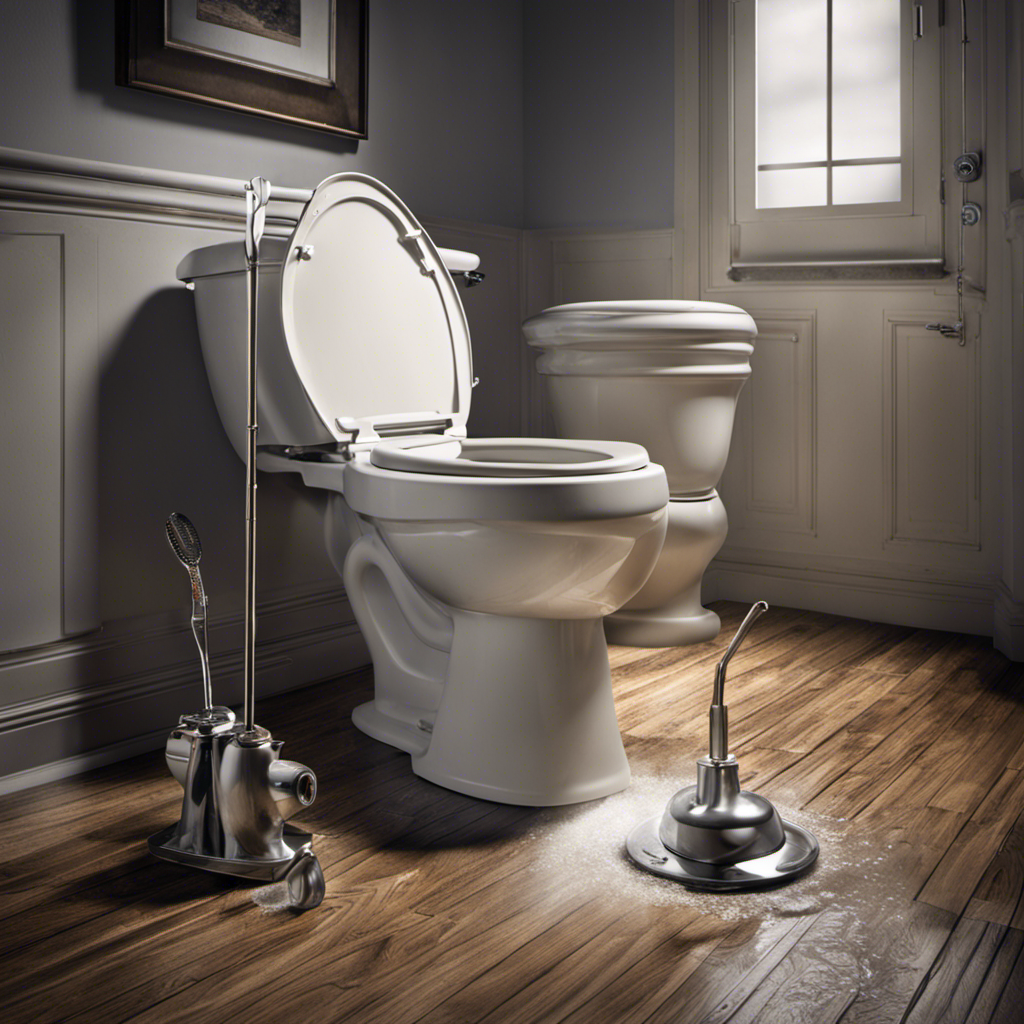Hey there, have you ever wondered why your toilet seems to be running all the time? Well, I’ve got some answers for you. In this article, I’m going to delve into the common causes of a running toilet and how you can fix it yourself.
We’ll explore the inner workings of the water supply mechanism, discuss faulty flappers and fill valves, and even troubleshoot a leaking flush valve.
So, sit tight and get ready to become a toilet troubleshooting pro!
Key Takeaways
- A running toilet is commonly caused by a faulty flapper valve, stuck or misaligned float, defective fill valve, or a clogged toilet tank.
- Understanding the water supply mechanism is important as a faulty flapper valve can lead to a running toilet, and adjusting the water level in the tank is crucial for water conservation.
- To prevent a running toilet, regularly check if the tank is refilling properly and adjust the fill valve if necessary.
- The flapper valve should be checked for continuous water leakage, cleaned and maintained regularly, and replaced if cracked or damaged. Adjusting the chain length and considering a flapper with a silicone seal can also help.
Common Causes of a Running Toilet
One common cause of a running toilet is a faulty flapper valve that needs to be replaced. The flapper valve is responsible for controlling the flow of water from the tank to the bowl. When it becomes worn out or damaged, water can continuously leak into the bowl, causing the toilet to constantly run.
Other causes of a running toilet include a stuck or misaligned float, a defective fill valve, or a clogged toilet tank. To resolve these issues, you can try adjusting the float, cleaning or replacing the fill valve, or unclogging the tank.
If these solutions don’t work, it may be necessary to call a plumber to diagnose and fix the problem.
Understanding the Water Supply Mechanism
When it comes to understanding the water supply mechanism in a toilet, there are a few key points to consider.
Firstly, the process of toilet tank refilling plays a crucial role in maintaining the proper functioning of the toilet.
Secondly, a faulty flapper valve can often be the culprit behind a running toilet, as it fails to seal the tank properly and allows water to continuously flow.
Lastly, adjusting the water level in the tank is an important step in preventing water waste and ensuring optimal performance.
Toilet Tank Refilling
To fix the running toilet, you’ll need to check if the toilet tank is refilling properly. This is an important step in toilet tank maintenance and can help you conserve water.
When the toilet is flushed, water from the tank is released into the bowl to flush away waste. After the flush, the tank needs to refill with water to be ready for the next use. If the tank is not refilling properly, it can cause the toilet to run continuously, wasting water.
To ensure proper refilling, check if the water level in the tank reaches the water line marked inside the tank. If not, adjust the fill valve to allow more water into the tank. Regularly checking the tank refilling process can help you save water and prevent costly water bills.
Faulty Flapper Valve
Check if the flapper valve is faulty by observing if water is continuously leaking from the tank into the bowl. If you see water constantly flowing into the bowl, it’s likely that the flapper valve is not sealing properly. Flapper maintenance is important to ensure the efficient functioning of your toilet. Here are some tips to keep your flapper in good shape:
- Regularly clean the flapper to remove any debris or mineral buildup.
- Check for any cracks or damage in the flapper and replace if necessary.
- Adjust the chain length to ensure the flapper closes fully.
- Consider using a flapper with a silicone seal for better durability.
- If all else fails, it may be time for a flapper replacement.
Taking care of your flapper valve will help prevent water wastage and keep your toilet running smoothly.
Now, let’s move on to adjusting the water level in the tank.
Water Level Adjustment
You can easily adjust the water level in your tank by using the float adjustment screw.
Proper water level maintenance is crucial to prevent toilet water overflow and ensure the efficient functioning of your toilet.
To adjust the water level, locate the float adjustment screw on the fill valve. Turn the screw clockwise to lower the water level or counterclockwise to raise it.
It’s important to find the right water level, which is typically marked on the overflow tube or indicated by a water line on the tank. Adjusting the water level too high can cause continuous running, while setting it too low may result in insufficient flushing power.
Now that you know how to adjust the water level, let’s move on to identifying and fixing a faulty flapper.
Identifying and Fixing a Faulty Flapper
When it comes to fixing a faulty flapper in your toilet, there are a few key points to keep in mind.
First, understanding the flapper replacement method is crucial for a successful repair. This involves removing the old flapper and installing a new one, ensuring a proper seal to prevent water leakage.
Additionally, being aware of common flapper issues such as deterioration, misalignment, or chain problems will help you troubleshoot and resolve the problem effectively.
Flapper Replacement Method
To fix a running toilet, the most common method is to replace the flapper. This small rubber valve is responsible for controlling the flow of water from the tank into the bowl. Over time, the flapper can become worn out or damaged, leading to toilet water leakage and the continuous running of the toilet.
To replace the flapper, follow these steps:
- Turn off the water supply to the toilet
- Flush the toilet to drain the tank
- Remove the old flapper by disconnecting it from the flush valve
- Attach the new flapper to the flush valve
- Turn on the water supply and test the toilet for any leaks.
Common Flapper Issues
If your toilet has a flapper that is not sealing properly, it can result in water leakage and a continuous flow. Flapper maintenance is essential to ensure that your toilet functions efficiently. One common issue with flappers is wear and tear, which can cause them to become warped or damaged over time. In this case, flapper repair may be necessary.
To repair a flapper, start by turning off the water supply to the toilet. Remove the old flapper and replace it with a new one that matches the make and model of your toilet. Make sure the flapper is properly aligned and securely attached. Finally, turn the water supply back on and check for any leaks.
By properly maintaining and repairing your flapper, you can prevent water wastage and ensure the smooth operation of your toilet.
Now, let’s move on to fixing a faulty fill valve.
Fixing a Faulty Fill Valve
You can easily fix a faulty fill valve by adjusting the water level in your toilet tank. Here are some steps to troubleshoot and fix fill valve issues:
-
Check the water level: Make sure the water level in the tank is not too high or too low. Adjust it to the recommended level.
-
Clean the fill valve: Sediment or debris can clog the fill valve. Turn off the water supply, remove the valve, and clean it thoroughly.
-
Replace the fill valve: If cleaning doesn’t solve the problem, you may need to replace the fill valve. Turn off the water supply, remove the old valve, and install a new one.
-
Adjust the float arm: Sometimes, the float arm may be bent or misaligned. Adjust it so that it allows the water to fill to the correct level.
-
Check the water pressure: High water pressure can cause the fill valve to malfunction. Install a pressure-reducing valve if needed.
Adjusting the Float to Stop Toilet Running
After fixing a faulty fill valve, the next step in troubleshooting a running toilet is to adjust the float mechanism. The float is responsible for controlling the water level in the tank, and if it’s not set correctly, it can cause water overflow and continuous running. To adjust the float, follow these steps:
- Remove the tank lid and locate the float and the fill valve.
- Look for a metal or plastic rod connected to the float. This is the adjustment rod.
- Gently bend the adjustment rod to lower or raise the float. Lowering the float will decrease the water level, while raising it will increase the water level.
- Test the adjustment by flushing the toilet and observing if the water stops running before reaching the overflow tube.
By adjusting the float mechanism, you can effectively troubleshoot water overflow and stop your toilet from running unnecessarily.
| Steps to Adjust the Float |
|---|
| Remove tank lid |
| Locate float and fill valve |
| Find the adjustment rod |
| Bend the adjustment rod to raise or lower the float |
Troubleshooting a Leaking Flush Valve
When troubleshooting a leaking flush valve, check for any cracks or damage in the valve itself. This can often be the cause of a running toilet and may require some repairs.
Here are some steps to help diagnose and troubleshoot the issue:
- Inspect the flush valve for any visible cracks or damage.
- Check the flapper for proper alignment and seating.
- Ensure that the chain connecting the flapper to the flush handle is properly adjusted.
- Examine the water level in the tank and adjust if necessary.
- Test the water pressure in your home to see if it’s within the recommended range.
Professional Help: When to Call a Plumber for a Running Toilet
Now that we have discussed troubleshooting a leaking flush valve, let’s talk about when it’s time to call in the professionals for a running toilet.
While DIY troubleshooting can solve many common toilet issues, there are certain situations where it’s best to seek the help of a plumber.
If you have tried all the DIY fixes and your toilet is still running, it may indicate a more serious problem. This could be due to issues with the fill valve, flapper, or even the water supply line. A plumber has the knowledge and expertise to identify and fix these problems efficiently.
Additionally, if you are not comfortable working with plumbing systems or lack the necessary tools, it’s safer to leave the job to the professionals. Attempting complex repairs without proper training can lead to further damage and potential water leaks.
Conclusion
In conclusion, dealing with a running toilet can be a frustrating experience. However, with a little knowledge and some basic troubleshooting, you can often fix the issue yourself.
Remember the old saying, ‘A stitch in time saves nine.’ By addressing the problem early on, you not only save water and money but also prevent more serious plumbing issues down the line.
So don’t let a running toilet dampen your spirits, tackle the problem head-on and enjoy the satisfaction of a fully functioning bathroom.










